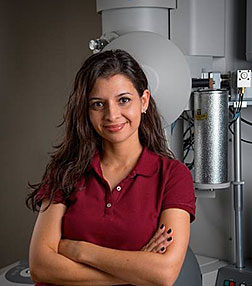- Number 401 |
- November 18, 2013
Ilke Arslan: A catalyst for clarity

Ilke Arslan at DOE’s Pacific Northwest
National Laboratory focuses on a technique
used to reconstruct the 3D morphology of
nanoparticles based on a series of 2D
images. The images Arslan and her
colleagues make possible will answer key
questions in catalysis, critical for improving
our global energy landscape.
A diplomat’s daughter, Ilke Arslan spent her childhood listening to different perspectives and asking questions as she travelled between Turkey and the rest of the world. She quickly learned meaningful change meant understanding a situation from all sides and that a flat or simplistic view would not do. Growing up living in Turkey, New York, Chicago, and visiting her father as he was stationed in Vietnam and Mexico, she saw, first hand, the economic, environmental, and security costs of our global energy situation.
"The experiences of global travel and many social engagements with various diplomats and ambassadors throughout my childhood allowed me see people and challenges from different vantage points. It drove me to find ways to really dig into problems and to work together to build answers," said Arslan, who works at DOE's Pacific Northwest National Laboratory.
At the age of 17, she went off to the University of Illinois in Chicago, where she earned her bachelor's degree in physics and a minor in Spanish, to complement her English and Turkish. As part of her minor in Spanish, she spent several months studying abroad in Spain. In her spare time, she played first clarinet in the university’s band, played briefly on the women’s tennis team, taught tennis, and danced in a professional company for artistic events throughout Chicago. After finishing her master’s degree in physics, she left Chicago's cold winters for sunny California, where she completed her doctoral degree in physics at UC Davis at the age of 25.
"She applies the fundamentals of physics to change our view of nanoparticles - working to give us that trifecta - a clear view of a working catalyst in real time, in three dimensions, and at the atomic scale," said Louis Terminello, who leads PNNL's Chemical Imaging Initiative.
Arslan's work focuses on electron tomography, a technique used to reconstruct the 3D morphology of nanoparticles based on a series of flat, or 2D, images from electron microscope. By forging teams of chemists, computer scientists, mathematicians, and others, she is leading projects into everything from the microscope's inner workings to the algorithms that build the models from the less-than-perfect images obtained as the catalyst moves.
"Being at a national lab is a perfect place to work towards the goal of 3D in situ imaging," said Arslan. "Through PNNL's Chemical Imaging Initiative, we have the collaborative teams necessary to build the tools to obtain images of particles as they undergo reactions. And through collaborations within the Laboratory on developing new algorithms, we are putting it all together in 3D."
The images Arslan and her colleagues make possible will answer key questions, including those being studied as part of PNNL’s Institute for Integrated Catalysis. "Scanning probe microscopies transformed surface science by providing scientists a direct atomic-scale probe of the structure and processes at 2D interfaces. The new 3D imaging techniques hold the promise of a similar transformation by opening doors to studying materials important in a variety of energy technologies, from new catalytic processes for creating biofuels to long-lasting, high-capacity batteries," said Bruce Garrett, who leads the Physical Sciences Division at PNNL.
Arslan's research is already earning attention. In 2009, President Barack Obama presented her with one of 13 Presidential Early Career Awards in Science and Engineering from DOE (about 85 awards were given in total). Other honors include research fellowships from the Royal Society, the National Science Foundation, and the Harry S. Truman Fellowship from Sandia National Laboratories, where she worked after finishing her postdoctoral assignment at the University of Cambridge, UK.
"I think one of the fringe benefits of the research and the attention it has drawn is getting to share this research with others," said Arslan, who is known as a dynamic speaker. She shares her research through scientific symposiums and workshops she organizes in the U.S. and abroad. Also, she serves as a tour speaker for the Microscopy Society of America and just attended the 25th U.S. Kavli Frontiers of Science Symposium, an invite-only National Academy of Sciences event.
Whether inside a laboratory with a team of microscopy experts or around the dinner table with her own kids, Arslan knows the value of looking at problems from different angles and doing the hard work to find solutions. The result? Crystal clear images of hard-working catalysts and an energized and excited team.Submitted by DOE's Pacific Northwest National Laboratory
